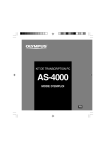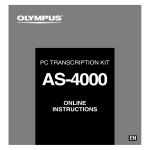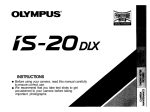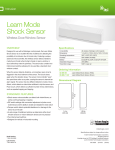Download Olympus Infinity Stylus Infinity Stylus User's Manual
Transcript
INSTRUCTIONS Description of controls LCD panel Shutter release button Flash reflector Autofocus windows Lens barrier Rewind button Light sensor Self-timer button Flash mode button Self-timer signal Viewfinder Autofocus indicator Flash indicator Viewfinder indicators Close-up correction marks Autofocus frame Strap Eyelet Fill-in flash LCD panel Battery remaining indicator Tripod socket Film window Back cover release Battery compartment cover AUTO/AUTO-S flash Flash OFF Exposure counter 2 Table of contents Description of controls.................................... 1 Before you begin . . . . . . . . . . . . . . . . . . . . . . . . . . . . . . . . . . . . . . . . . . . 5 Loading the battery........................................ 5 Simple point & shoot photography .................... 7 Loading the film............................................ 7 Unloading the film........................................ 11 How to take pictures..................................... 13 Auto flash photography (1) Taking pictures in low light......................... 18 Auto flash photography (2) Taking backlighted subjects ........................ 20 3 Camera functions and controls........................ 21 Close-up (Macro) photography........................ 21 Focus lock.................................................. 22 Self-timer photography.................................. 24 Flash AUTO-S mode.................................... 25 Flash OFF mode.......................................... 27 FILL-IN flash mode .................................... 28 Attaching the strap /How to use the soft case..... 29 Troubleshooting . . . . . . . . . . . . . . . . . . . . . . . . . . . . . . . . . . . . . . . . . . . 31 Care and storage.......................................... 33 Specifications .............................................. 34 Thank you for purchasing the Olympus Please read this instruction manual carefully before using the camera. This camera will not operate unless the lens barrier is opened. We also recommend that you shoot at least one roll of film to familiarize yourself with the camera's features. Symbols used in this manual Correct Incorrect Operation Order of operation Operating sound Lamp on Lamp blinking Attention 4 Automatic operation Press lightly Before you begin Open the battery compartment cover. *Remove the battery if you do not plan to use the camera for an extended period of time. Loading the battery 5 Insert the new battery correctly as indicated below and close the battery compartment cover tightly. *Use a 3V lithium battery (Duracell DL123A, Panasonic CR123A, or equivalent.) *Open the battery compartment cover and remove the battery, as illustrated below, when replacing the battery. *Be sure to close the lens barrier when replacing the battery. Open the lens barrier as shown below until you hear a "Click" and check the battery power remaining. When is displayed (Approx. 12 sec.), battery is OK. If flashes, battery is low, have spare handy. If is displayed continuously, battery should be replaced immediately. *When closing the lens barrier, slide gently to allow the lens to retract as the barrier is being closed. 6 Simple point and shoot photography Open the back cover by sliding the back cover release toward the top of the camera. Loading the film This camera is designed to use DX coded 35 mm film to automatically set film speed. If DX-coded film is unavailable, use ISO 100 film. 7 The camera back will open. Prepare a "DX" film cartridge. The camera will set itself automatically for DX-coded film speeds from ISO 50 to 3200. Insert the film cartridge into the camera. Avoid direct sunlight when loading the film. *When using non-DX film, the film speed is automatically set to ISO 100. 8 Be sure the film is lying flat. Align the film leader with the red film loading indicator. Close the camera back firmly. * Adjust the length of the film leader before loading so that it matches with the red loading indicator. Make sure the film leader tip is not bent and the film perforations are (Make sure the back cover lock properly aligned and engaged as shown. 9 snaps down.) Open the lens barrier until you hear a "Click". Be sure the exposure counter on the LCD panel will display a number "1" indicating the first picture on the roll. * If the film is improperly loaded, the LCD panel will display a blinking "E" as shown in the illustration (B). In this case, open the back cover, and realign the film leader. 10 * Use the window in the camera back to check type of film loaded. Unloading the film The camera automatically rewinds the film when you reach the end of the roll. You will hear the motor operating and the exposure counter will count down as the film is rewinding. The final reading on the exposure counter before rewinding may be more than the number of exposures specified for the film. 11 If you want to rewind the film before the end of a roll, press the rewind button with the tip of a ballpoint pen. Do not use any device with a sharp tip and do not press the rewind button too hard. Open the back cover after the motor has stopped. Once the film has been rewound, a blinking "E" will be displayed on the LCD panel. Further operations are not possible until the rewound film cartridge is removed. 12 Remove the film cartridge from the camera in the shade. Slide the lens barrier as far as it will go until you hear a click. (The shutter will not release unless the lens barrier is fully open.) When the camera is not in use, always close this barrier so that the How to take pictures shutter will not release accidentally. When the lens barrier is opened, normal shooting mode (AUTO or AUTO-S) will be indicated on the LCD panel. After 4.5 minutes, the LCD will go out. 13 Hold the camera correctly. Keep your fingers and the strap away from the lens, viewfinder and flash reflector. 14 Position your subject within the autofocus frame. Press the shutter release button lightly and confirm that the autofocus lamp (green) to the right of the viewfinder is lighted. 15 The subject should be within the picture frame. *If the distance between the subject and the camera is set at 0.35 m (1.1 ft.), the picture area will be inside the close-up Shooting range: From 0.35 m (1.1 ft.) to— (infinity) correction marks as shown in the illustration. *If the distance between the subject and the camera is less than 0.35 m (1.1 ft.), the autofocus lamp (green) to the right of the viewfinder will blink and shutter will not release. However, the shutter may sometimes be released erroneously when the subject is extremely close to the camera. 16 Press the shutter release button (Gently to minimize camera shake.) As soon as the shutter is released, the film will automatically advance to the next frame. You will hear the motor operating. The exposure counter will advance to the next frame when film winding is completed. 17 Auto flash photography If you are taking pictures in low light, the flash lamp (orange) to the right of the viewfinder and the red lamp on the front of the camera will light when the shutter release button is pressed halfway. •While the flash is still charging and the flash lamp (orange) is blinking, the shutter will not release. •It takes about 3 sec. after the film is advanced to recharge the flash (at normal temperatures). (1) Taking pictures in low light In low light situations, the flash will activate automatically when the flash mode is AUTO or AUTO-S. 18 Flash shooting range: The flash will activate automatically when the shutter release button is fully pressed. (ISO 100) 0.35 m (1.1 ft.)—3.5 m (11.5 ft.) (ISO 400) 0.35 m (1.1 ft.)—7m (23 ft.) *The flash range as shown below is optimal for color negative film. Actual flash working range for other film types may vary. 19 Auto flash photography If you are taking backlighted subjects, the flash lamp (orange) and red lamp on the front of the camera will light when the shutter release button is pressed halfway. (2) Taking backlighted subjects In backlighted situations, the flash will activate automatically when the flash mode is AUTO or AUTO-S. 20 This indicates that the flash will activate automatically. If the backlighted subject is so small that it does not fill the autofocus frame, the flash may not activate automatically. In this case, use the FILL-IN flash mode. (Refer to p. 27) Camera functions and controls *When the distance between the subject and the camera is 0.35 m (1.1 ft.), compose your shot within the close-up correction marks as shown in the illustration. Close-up correction marks Close-up photography Be careful of the flash's light when shooting people's faces in closeup photography. 21 * When shooting within the close-up range, to prevent blurred pictures resulting from camera shake, set the camera firmly in position (on a tripod, for example). Position your subject in the autofocus frame and press the shutter release button halfway. The autofocus indicator (green) will light in the viewfinder. Focus lock *When focus is locked, exposure settings are also locked (AE lock). Use the locus lock when you want to position your subject outside the autofocus frame in the center of the viewfinder. 22 While keeping the shutter release Press the shutter release button button pressed halfway, change fully to take the picture. the position of your subject in *If you remove your finger from the viewfinder to achieve the the shutter release button while desired composition. the autofocus indicator (green) lights, the focus lock will be canceled. 23 While pressing the self-timer button press the shutter release button fully to activate the self-timer. The shutter will be released 12 seconds later Self-timer photography *Be sure the subject is in the autofocus frame. *The red lamp on the front of the camera will light up for the first 10 seconds, then blink rapidly for 2 seconds until the shutter is released. To cancel the self-timer, close the lens barrier or press the button again. *After the shutter is released, the self-timer mode will be automatically canceled. 24 Press the flash mode button until " AUTO-S" appears on the LCD panel. Auto-S flash photography Compose your shot and press the shutter release button — the flash will emit a rapid series of pre flashes, followed directly by the main flash. Hold the camera firmly while pressing the shutter release button. Auto-S flash significantly reduces "Red-eye" phenomenon (when a subject's eyes appear red) in flash portraits and group photos. 25 Flash AUTO-S mode shooting range: Press the flash mode button until " OFF" appears on the LCD panel. (ISO 100) 0.35 m (1.1 ft.) —3.5 m (11.5 ft.) (ISO 400) 0.35 m —7 m (23 ft.) *To cancel Auto-S mode, press the flash mode button again. * Auto-S mode will not be canceled, when the lens barrier is closed. Flash OFF mode This mode is to be used in situations where a flash is prohibited (as in museums) or when not desired (for special effects). 26 *In low lighting condition, the shutter speed may be slow. Use a tripod or other camera support to prevent the effects of camera shake. *With backlighting the subject may be too dark. Press the shutter release button fully to take the picture. *To cancel flash OFF mode press the flash mode button again or close the lens barrier. FILL-IN flash mode The flash always activates in this mode. It can be engaged for daylight synchro photography or when shooting backlighted subjects. 27 *By using the flash FILL-IN mode, the subject will be properly lit by the flash. Press the flash mode button until " FILL-IN" appears on the LCD panel. Press the shutter release button fully to take the picture. *To cancel Fill-in flash mode, press the flash mode button again or close the lens barrier. 28 Attach the strap to the camera according to the directions illustrated below. Attaching the strap Use of the optional Olympus case 29 Be sure the lens barrier is closed before the camera is inserted into the case. 30 Troubleshooting release if the barrier has been left open over 4 hours. Q: Will the camera operate without film? A: Even if there is no film in the camera, if the lens barrier is open, the shutter will release. Under low light the flash will activate. If the lens barrier is closed, the camera will not operate; and if the flash is activated in rapid succession, the camera may get warm. (In the latter case, pause between shots.) Close and re-open the barrier once before shooting. Q: The flash does not activate. A: Check the flash mode. Q: How long does the battery last? A: Since lithium batteries have extra long lives, you can shoot approximately 20 rolls of 24-exp. film. Using a flash will shorten the life of a battery by about 50%; thus if you use the flash less frequently, the battery will last longer. Q: The camera does not work in extremely cold weather. What should I do? A: In low temperature conditions, batteries temporarily Q: The camera will not operate. What shall I do? A: (1) Open the lens barrier fully. (2) Be sure the battery is placed in the camera correctly and that the battery power isn't low. (3) The camera will not operate when the flash is recharging. (4) Be sure the subject is not closer than the shooting distance. (5) The camera will not operate until the camera back has been opened af- lose performance. Try to keep the camera warm. ter the film has been rewound. (6) The shutter will not 31 Q: The pictures aren't sharp. What's wrong? A: In the following examples, the camera's autofocus mechanism may not function properly. Use the focus lock mechanism when taking pictures of: a. (1) Objects that reflect too much light (2) Black objects (3) Objects through glass windows or wire screens (4) Subjects in which flames or smoke are included (5) Subjects in which the sun is part of the picture. b. Subjects in high - light situations, such as summer sea shores or snowy mountains. Q: Where can I buy lithium batteries? A: At your local camera dealer or nearest Olympus service center. When purchasing batteries, order Duracell DL123A or Panasonic CR123A, or equivalent. 32 Care and storage *Do not expose the camera to extreme heat (over 40°C or 104°F) or to extreme cold (below -10°C or 14°F). *Avoid sudden temperature change. *Do not expose the camera to strong magnetic fields. *Do not apply excess force to the camera or its controls. *Do not rotate the camera once it is mounted on a tripod. Avoid opening the camera when it is mounted on a tripod. *Do not touch the contact points inside the camera. 33 *Do not use organic solvents, thinner or benzine to clean the camera. *Avoid high impact from bumping or dropping the camera. *Do not expose the camera to rain shower and water. *Never disassemble the camera; it contains a highvoltage circuit. *Do not disassemble or expose batteries to excessive heat. *In case of malfunctions, consult your nearest Olympus dealer, or nearest Olympus service center. Specifications Type: Fully automatic 35 mm autofocus lens-shutter camera Film format: 35 mm standard DX coded film (24 x 36 mm) Lens: Olympus lens 35 mm F3.5, 3 elements in 3 groups Shutter: Programmed electronic shutter Viewfinder: Active type viewfinder type 0.4X (with autofocus frame, close-up correction marks, flash indicator, AF indicator). Focusing: Active type autofocus system, focus lock possible. Focusing range: 0.35 m (1.1 ft.)— (infinity) Exposure control: Automatic exposure control with programmed electronic shutter. Automatic control range with ISO 100 film: EV 7.5 (F3.5, 1 /15 set) to EV 17 (F16, 1/500 sec) Exposure counter: Progressive type LCD panel 34 Selftimer: Electronic selftimer with 12-second delay (While pressing the self-timer button, press the shutter release button to activate self-timer. Red LED turns ON) Film speed range: Automatic setting with DX-coded film (ISO 50—3200). Actual setting at ISO 50, 100, 200, 400, 800, 1600 and 3200. Film loading: Automatic loading, (automatically advances to first frame when camera back is closed) Film advance: Automatic film winding. Film rewind: Automatic rewinding (automatic rewind activation at the end of film, automatic rewind stop), rewind possible at any point with rewind button. Flash: Built-in. Recycling time approx. 3 sec. (at normal temperature). Flash range with color negative film: ISO 100 film: 0.35 m (1.1 ft.) —3.5 m (11.5 ft.). ISO 400 film: 0.35 m (1.1 ft.) —7 m (23 ft.). Flash modes: AUTO (automatic flash activation in low light and backlight), AUTO-S (automatic flash activation in low light and backlight), OFF (no flash), and FILL-IN (forced activation). Battery check: Display on LCD Lens barrier: Sliding type (with release lock) Power source: 3V lithium battery (DL123A, CR123A or equivalent) Dimensions: 117 (W) x 63 (H) x 37 (D) (4.6" x 2.5" x 1.4") Weight: 170 g (6.0 oz.) (without battery) *Specifications and design are subject to change without notice. **Specifications according to a DL123A/CR123A power source. 35 OLYMPUS OPTICAL CO., LTD. San-Ei Building, 22-2, Nishi Shinjuku 1-chome, Shinjuku-ku, Tokyo, Japan. Tel. 03-3340-2211 OLYMPUS AMERICA INC. Two Corporate Center Drive, Melville, NY 11747-3157, U.S.A. Tel. 516-844-6000 OLYMPUS OPTICAL CO. (EUROPA) GMBH. (Premises/Goods delivery) Wendenstrasse 14-16, 20097 Hamburg, Germany. Tel. 040-237730 (Letters) Postfach 10 49 08, 20034 Hamburg, Germany. OLYMPUS OPTICAL CO (UK.) LTD. 2-8 Honduras Street, London EC1Y 0TX, United Kingdom. Tel. 0171-253-2772 Copyright © OLYMPUS OPTICAL CO., LTD. (Tokyo) PRINTED IN HONGKONG 0592 50MM
















































